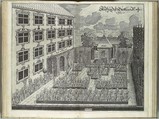Architectura Privata: Das is Gründtliche Beschreibung...in was form...ein Burgerliches Wohn-Haus...
Not on view
Furttenbach's intimate garden courtyard with a small grotto, richly decorated with rare flowers arranged in several compartments, illustrates the intimate "secret garden" owned by the wealthy bourgeoisie in early seventeenth-century Germany and the Netherlands. Furttenbach describes the grotto in his garden as being filled with artifice and exotica, including shell-encrusted sculptures and waterworks, painted cosmological imagery, and mirrors. His garden is a kind of open-air museum where the plants constitute the valued, living statues. The flowers are identifiable as the most sought after and costly bulbs of the period, the narcissus, tulip, fritillary, and crown imperial, demonstrating Furttenbach's knowledge of current botanical research.
This image cannot be enlarged, viewed at full screen, or downloaded.

